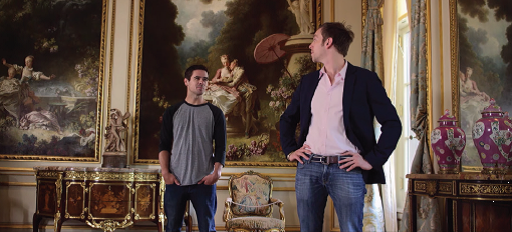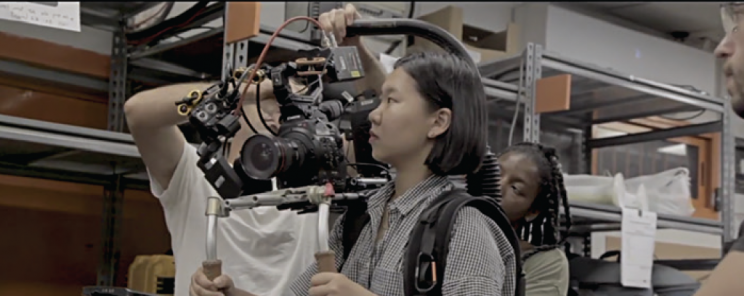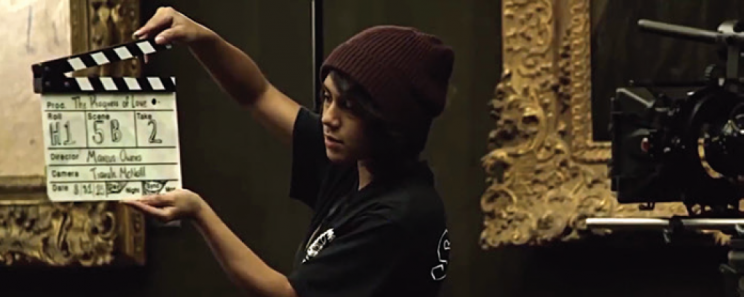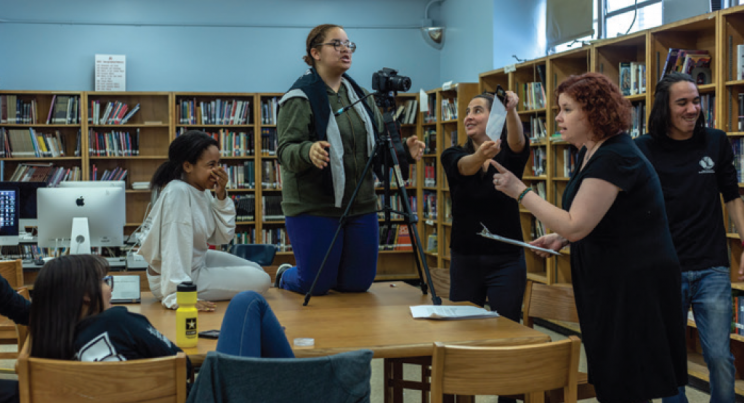
Over just the past two decades, the role of filmmaking in youth media education has become newly essential and rewarding.
By Chris Wisniewski, Executive Director, Alliance for Young Artists & Writers/Scholastic Art & Writing Awards
Reprinted from Film Comment September-October 2019 with permission from Film at Lincoln Center. © Film Comment 2019. filmcomment.com
In 2016, the Ghetto Film School, a nonprofit film education organization that runs programming for teens in New York, Los Angeles, and London, debuted the first of several short films made through a collaboration with the Frick Collection in New York. Inspired by a series of works by the French painter Jean-Honoré Fragonard, The Progress of Love tells a story of queer romance and heartbreak that pivots on the Fragonard series that shares its title. Written and produced by Gabby Martinez and directed by Marcus Owens, The Progress of Love is a remarkable piece of youth media. From a purely technical perspective, it demonstrates a high level of competence: it is thoughtfully framed and edited and well-acted, with a commendably clean sound mix (most youth-made films fall short on these measures in particular).
Beyond its technical merits, the 14-minute film displays a committed approach to visual storytelling and a sophistication concerning adult emotions that are exceptional for youth-produced work. The titular paintings are its starting point, with the conversation that instigates the narrative set in the Fragonard room of the Frick. The exchange between the film’s central characters serves as both a primer on reading images—one by one, they tease out the narrative elements of each of the four paintings in the series—as well as a roadmap of Fragonard’s optimistic depiction of love. The brief scenes that follow invert Fragonard’s romantic scheme, charting the love affair’s disintegration in fleeting vignettes. As a short film, The Progress of Love is sturdy and earnest. It is noteworthy, however, precisely because it’s a work made by teenagers.
It would be easy to attribute The Progress of Love’s merits to one or several preternaturally talented young people. However, subsequent entries in the Frick collaboration series share its broadminded approach to the intersection of film and visual art, as well as its mature and knowing take on love and loss. These works emerged through an initiative of two committed, active partners, with Ghetto Film School providing the youth-media expertise and the Frick offering exclusive access to the museum for participating teens, involving discussions of the collection led by the museum’s Chief Curator Xavier Salomon. On superficial terms, the pairing of the two organizations is an unexpected one (the match was initially brokered by Elizabeth “Buffy” Easton, founder of the Center for Curatorial Leadership), and it represents two organizations stretching into new territory. To survey the shorts produced in this Ghetto Film School/Frick effort is to see the result of an ambitious educational initiative that clearly succeeds in what it sets out to do, showcasing the vision of young mediamakers while giving them the training they need to become successful cinematic storytellers.
In the two decades since it was founded by Joe Hall, a former social worker, Ghetto Film School has been a standard-bearer and leader in the youth-media space. Its programs provide teens, particularly young people of color, with an opportunity to learn about the craft of narrative filmmaking and hone their creative talents under the guidance of accomplished mentors and skilled media educators. Hall describes its mission as “inclusive because access and opportunity are front and center . . . [and] elite because it is very competitive to gain entrance . . . requiring enormous dedication and hard work by students.” The resources it offers in exchange, though, are significant. For example, on top of the highly specialized level of access granted to Martinez and the rest of her cohort, The Progress of Love’s screenwriter also benefited from a table read with creative input from Baz Luhrmann and Alfre Woodard; in this sense, Ghetto Film School has few peers.

But while there is no other organization in the country quite like it, Ghetto Film School is part of a landscape that is increasingly crowded, where young people at ever earlier ages are being instructed in the practice of “content creation,” whether one labels this filmmaking, media arts, moving-image creation, or any other number of buzzy descriptors that all essentially serve as labels for youth making movies.
This year, the New York City Department of Education, working with the Mayor’s Office of Media and Entertainment, hosted what it billed as its first annual “Public School Film Festival,” featuring 20 short films from middle and high school students citywide selected by a panel of public-school film teachers and industry professionals. The categories included Feature/Narrative, Animation, Experimental, PSA Advocacy, and Documentary, and the morning screening was followed by an afternoon panel that gave students an opportunity to learn about careers in the industry. In many ways, the film festival represents the fulfillment of a promise made a little over a decade ago, when the same city agencies, in partnership with the Tribeca Film Institute and field leaders from a range of partner organizations, authored the Blueprint for Teaching and Learning in the Moving Image, one of the country’s first standards-based curricular frameworks for media education. (At the time, I served as Director of Education at Museum of the Moving Image in Astoria, Queens, and was one of the authors of the Blueprint.)
The moving image Blueprint was produced several years after a series of similar documents relating to other art forms, including visual arts, music, theater, and dance. Each outlines certain “benchmarks” for student achievement across five strands: making, literacy, cross-curricular connections, connections to community, and careers and lifelong learning. The Blueprint was followed in 2014 by the release of Media Arts standards as part of the rollout of the National Core Arts Standards, which have since been adapted and adopted by many states across the country. Nelle Stokes, the Founding Executive Director of the media arts organization Magic Box Productions, served on the committee to write the national standards, their New York State counterparts, and the Blueprint. She argues, “For teachers, the new national and New York State standards offer ways to look at media making in terms of ‘process’ rather than strictly the final product.”
There are many subtle differences among these standards that are relevant and meaningful to arts education professionals. For the layperson, the most striking contrast may be structural. The Blueprint is divided into sections for film, television, and animation—distinctions that hardly seem meaningful today—whereas the very term “media arts” feels like a nod to the convergence of the three Blueprint media that accelerated in the years separating the two documents’ creations. In many ways, the art form has been moving too quickly for those who wish to think about how to codify a way of teaching young people how to watch, interpret, and create media.

Film education programs have existed at schools and cultural institutions for decades. But in the early 2000s and before, the cost of equipment and labor-intensive nature of film production made such offerings rarified, to say the least. Christine L. Mendoza, the Director of Education at Film at Lincoln Center, had her first experience in the media education field as a student in the late ’90s. “The field has not shifted much in terms of best practices and educational philosophies,” Mendoza said, “but it has shifted with the technological times.” Indeed, Film at Lincoln Center’s education programs are grounded in a model that involves exposure to classic and contemporary work as well as moving-image making in the classroom—a variation on an approach that has been associated with high-quality arts instruction across disciplines for decades.
Still, it is remarkable that now, media education in schools is common enough that nearly half the states in this country have adopted learning standards in the discipline. The consequence of technological changes is that instead of money and equipment serving as nearly insurmountable barriers to entry, time and expertise have become the larger issues. My personal experience at Museum of the Moving Image reflects this shift. When I took over the Museum’s education department in 2005, we offered no media-making programming of any kind. There were philosophical and pedagogical reasons for this, but we also faced practical constraints. At the time, an institution like ours continued to grapple seriously with the question of whether or not a filmmaking program would require the use of actual film. We had no cameras, lights, or sound equipment, and we also lacked an appropriate space for media making. Our first foray into moving-image creation was stop-motion animation, which had a much lower cost and fewer complicating variables, such as the need for sync sound, able performers, complicated sets, or even discernible stories.
When we finally introduced our first live-action program in 2008, we used Motorola RAZR cell phones and billed the class as a “viral video” program. The branding would have been unthinkable just a few years earlier, and in some sense it proved prescient. A recent New York Times feature on the future of the movies included a whole section on the question of whether young people under the age of 25 even watch entire movies or, instead, consume shorter pieces of media content, usually online, that may or may not be part of a larger whole. When we think about the media that young people view—and make—it may well be that viral video is more relevant to many teens than moviemaking. At the Museum in 2008, we were just beginning to understand this, and in doing so, we sidestepped the built-in challenges that come with presenting a museum-quality education program focused on live-action filmmaking. The very conceit of our viral video classes required a product that had a DIY aesthetic.
Today, Museum of the Moving Image offers a wide array of moving image–making programs for kids and teens both in schools and on-site, from audio labs to live-action video courses to classes dealing with puppetry for the screen. Reflecting on the goals of the Museum’s education programs, its current Deputy Director of Education and Community Engagement, Sara Guerrero, says, “We provide the tools for audiences to move from the role of passive content consumer to content creator.” In 2005, I would have answered this question very differently, in ways rooted more in the industrial, artistic, and cultural history of the moving image and how it is made, marketed, and consumed. Guerrero’s response is, of course, reflective of her particular aspirations for her programs, but it also demonstrates how much the landscape has shifted. Tools for media-making are ubiquitous, and most young people think of themselves as content creators. My philosophical ponderings about what it meant to teach young people to make moving images in 2005 are, on their face, stodgy and old-fashioned by the standards of 2019.

These changes are meaningful, and from the perspective of a cinephile, it will soon matter more. It is commonplace today to talk about what it means that Spike Lee and Ang Lee went to NYU or that Charles Burnett and Julie Dash belonged to a movement that started at UCLA. The emergence of reputable BFA and MFA programs at colleges and universities around the country in the ’70s and ’80s has had a lasting impact on the industry and the art form, one that is acknowledged in cinephile culture if not fully understood. To the extent that media education, abetted by cultural and technological change, has worked its way down and out into the K-12 education space since the turn of this century, we are entering a moment where many emergent makers will have had their first media education experience in middle school or high school, or through a program offered by an organization like Film at Lincoln Center, the Jacob Burns Film Center in Westchester, or Inner-City Arts in Los Angeles.
The impact of this shift will be difficult to track. In New York City, there are several media-themed high schools and many others with media programs. Often, though, students receive media instruction from teachers in other disciplines who demonstrate an interest and secure their administration’s commitment in terms of the necessary allocations of budgetary funds and instructional time. The Academy for Careers in Television and Film in Long Island City has a robust four-year curriculum that includes exposure to the functioning film and television production facilities in the neighborhood. This kind of training is different from the media instruction offered less than two miles away at Newcomers High School, a school with an academic focus that serves immigrant students who are new to the English language.
Any media education experience is defined by the instructional goals of the people designing and leading it, the format of the program, and the training of the teachers and curriculum writers. In this sense, media education should be thought of in the broader context of arts education, where these variables similarly impact the kind of education a student gets in even the most established arts disciplines like visual arts and music. Unlike English language arts and math, where high-stakes testing leads to built-in incentives to prioritize and teach an established curriculum, hire well-trained teachers, and give those teachers the time and resources they need across the entirety of a young person’s K-12 experience, arts educators are constantly fighting for time, money, training, and buy-in. It is not uncommon, for example, for visual arts teachers to have little or no studio art training, and it should not be surprising that this would also be true in media arts.
Even at the level of instructional goals, many of the debates around what quality media arts instruction looks like continually arise in other disciplines as well. Should the focus be on the development of technical skill or creative expression? What role should masterworks have in art instruction; who defines what a masterwork is anyway; and how do we ensure that the examples we use are diverse and relevant to students? Is the purpose of art instruction to cultivate appreciation, or to identify talented individuals and put them on a career path, or to stimulate the development of other skills—which could be as varied as language skills, ideation, or collaboration?
These debates have raged across the arts education field for decades. Further, one’s answers to these questions depend in part on who your students are and how you respond to their needs. As Joe Hall puts it, Ghetto Film School has a specific mission “to educate, develop, and celebrate the next generation of great American storytellers.” It makes sense for an organization with this mandate to offer the Frick program or to provide early career support for alumni entering the industry. Magic Box Productions, meanwhile, works with early elementary school students and English language–learners, an entirely different population with a different set of needs. Their “talking picture books” program, in which students use media and traditional art materials to translate a familiar story into an animation, is perfectly suited to this audience. Thankfully, the ecosystem is large enough for all of these organizations.
To the extent that schools, libraries, and arts education organizations are now offering media education programs, the moving image has become embedded in larger questions about K-12 public education in the United States and how it must change in order to respond to and equip young people for life in the 21st century. That discourse may seem far removed from the one that typically takes place around American art cinema, but their futures are intertwined. I came to this field initially as a cinephile, and early in my career, my priorities reflected that. I worried about teaching kids to be good moviegoers—making certain they left my tours of the Museum knowing who Charlie Chaplin, Sidney Poitier, and Thelma Schoonmaker were. In 2007, during one of our first stop-motion animation courses, I met a seventh-grade student who was a nonverbal immigrant living in Jackson Heights. During one class midway through the semester, he grabbed a camera, computer, and some Legos and took a seat by himself in the corner of the classroom. In 90 minutes, on his own, he created a 30-second animation called “Play Time,” a technically astounding nonnarrative piece in which a CD makes its way onto a Lego turntable and spins itself. The animation remains one of the most impressive student-made videos to come out of any of my programs. That was the first time I began to see what can happen to a young learner when they have the opportunity to make media—and in reflecting on that moment, I came to realize that media education is in some ways bigger than the art form that first brought me to this work.

